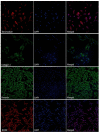Platelets Rich Plasma Increases Antioxidant Defenses of Tenocytes via Nrf2 Signal Pathway
- PMID: 37686103
- PMCID: PMC10488198
- DOI: 10.3390/ijms241713299
Platelets Rich Plasma Increases Antioxidant Defenses of Tenocytes via Nrf2 Signal Pathway
Abstract
Tendinopathies are common disabling conditions in equine and human athletes. The etiology is still unclear, although reactive oxygen species (ROS) and oxidative stress (OS) seem to play a crucial role. In addition, OS has been implicated in the failure of tendon lesion repair. Platelet-rich plasma (PRP) is rich in growth factors that promote tissue regeneration. This is a promising therapeutic approach in tendon injury. Moreover, growing evidence has been attributed to PRP antioxidant effects that can sustain tissue healing. In this study, the potential antioxidant effects of PRP in tenocytes exposed to oxidative stress were investigated. The results demonstrated that PRP reduces protein and lipid oxidative damage and protects tenocytes from OS-induced cell death. The results also showed that PRP was able to increase nuclear levels of redox-dependent transcription factor Nrf2 and to induce some antioxidant/phase II detoxifying enzymes (superoxide dismutase 2, catalase, heme oxygenase 1, NAD(P)H oxidoreductase quinone-1, glutamate cysteine ligase catalytic subunit and glutathione, S-transferase). Moreover, PRP also increased the enzymatic activity of catalase and glutathione S-transferase. In conclusion, this study suggests that PRP could activate various cellular signaling pathways, including the Nrf2 pathway, for the restoration of tenocyte homeostasis and to promote tendon regeneration and repair following tendon injuries.
Keywords: Nrf2; oxidative stress; platelet-rich plasma; protein oxidation; tendinopathy; tenocytes.
Conflict of interest statement
The authors declare no conflict of interest.
Figures





Similar articles
-
l-Methionine activates Nrf2-ARE pathway to induce endogenous antioxidant activity for depressing ROS-derived oxidative stress in growing rats.J Sci Food Agric. 2019 Aug 15;99(10):4849-4862. doi: 10.1002/jsfa.9757. Epub 2019 May 13. J Sci Food Agric. 2019. PMID: 31001831
-
Nuclear factor E2-related factor 2-dependent myocardiac cytoprotection against oxidative and electrophilic stress.Cardiovasc Toxicol. 2008 Summer;8(2):71-85. doi: 10.1007/s12012-008-9016-0. Epub 2008 May 8. Cardiovasc Toxicol. 2008. PMID: 18463988
-
Platelet-released growth factors can accelerate tenocyte proliferation and activate the anti-oxidant response element.Histochem Cell Biol. 2011 May;135(5):453-60. doi: 10.1007/s00418-011-0808-0. Epub 2011 Apr 8. Histochem Cell Biol. 2011. PMID: 21476078
-
Nrf2/ARE regulated antioxidant gene expression in endothelial and smooth muscle cells in oxidative stress: implications for atherosclerosis and preeclampsia.Sheng Li Xue Bao. 2007 Apr 25;59(2):117-27. Sheng Li Xue Bao. 2007. PMID: 17437032 Review.
-
Synergistic Interaction Between Heme Oxygenase (HO) and Nuclear-Factor E2- Related Factor-2 (Nrf2) against Oxidative Stress in Cardiovascular Related Diseases.Curr Pharm Des. 2017;23(10):1465-1470. doi: 10.2174/1381612823666170113153818. Curr Pharm Des. 2017. PMID: 28088909 Review.
Cited by
-
Tissue adhesive, ROS scavenging and injectable PRP-based 'plasticine' for promoting cartilage repair.Regen Biomater. 2023 Nov 21;11:rbad104. doi: 10.1093/rb/rbad104. eCollection 2024. Regen Biomater. 2023. PMID: 38235061 Free PMC article.
-
Comparison of autologous platelet concentrates and topical steroids on oral lichen planus: a systematic review and meta-analysis.BMC Oral Health. 2024 Jun 8;24(1):674. doi: 10.1186/s12903-024-04443-y. BMC Oral Health. 2024. PMID: 38851685 Free PMC article.
-
The Combined Use of Triamcinolone and Platelet-Rich Plasma in Equine Metacarpophalangeal Joint Osteoarthritis Treatments: An In Vivo and In Vitro Study.Animals (Basel). 2024 Dec 17;14(24):3645. doi: 10.3390/ani14243645. Animals (Basel). 2024. PMID: 39765549 Free PMC article.
-
Platelet-rich plasma may accelerate diabetic wound healing by modulating epithelial/endothelial-mesenchymal transition through inhibiting reactive oxygen species-mediated oxidative stress.Front Bioeng Biotechnol. 2025 Aug 11;13:1623780. doi: 10.3389/fbioe.2025.1623780. eCollection 2025. Front Bioeng Biotechnol. 2025. PMID: 40861861 Free PMC article.
-
A Retrospective Cohort Study Investigating the Effect of Intraovarian Platelet-Rich Plasma Therapy on the Oxidative State of Follicular Fluid in Women with Diminished Ovarian Reserve.Chonnam Med J. 2025 Jan;61(1):46-51. doi: 10.4068/cmj.2025.61.1.46. Epub 2025 Jan 24. Chonnam Med J. 2025. PMID: 39958271 Free PMC article.
References
MeSH terms
Substances
Grants and funding
LinkOut - more resources
Full Text Sources
Medical
Research Materials

